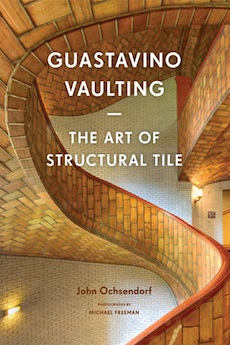By David Madden
Reviewing a book that is directly involved in an ongoing exhibition is an unusual and enjoyable experience.
From 1882 to l943, in 30 American states, and 6 countries, Rafael Guastavino and his son Rafael Jr., created more than 1,000 Catalan tile domes and vaultings that met their criteria of speed, health, safety, economy, and beauty.
Guastavino Vaulting. The Art of Structural Tile by McArthur Fellow and MIT professor John Ochsendorf was published in 2010 to enhance “Palaces For The People: Guastavino And America’s Great Public Spaces,” an exhibition about the lives and works of father and son. It opened to great acclaim in Boston, then moved to Washington, DC and New York City, and is now to be seen at the Swannanoa Valley Museum in the little town of Black Mountain, North Carolina, and will close December 2, 2017.
A native of Valencia, Spain, Rafael Guastavino, then 40 years old, arrived in New York with his 9-year-old son Rafael Jr. in 1881. He had been so successful as a master architect and tile artist in Spain in the era of Gaudi that he brought with him $40,000, a great sum for an immigrant in those days.
After many high and low points, he achieved his first great success in his adopted country by creating tile vaultings and ceilings throughout the new Boston Public Library using a unique, secret fire-proof sealing compound.
Awareness grew of the Guastavinos’ fine works in many types of buildings, several of which appeared on two lists of the country’s ten greatest.
George Vanderbilt contracted him to bring his talent for tile vaulting into major areas of the Biltmore Estate under construction in Asheville, North Carolina. Guastavino’s unique expertise may be seen in the Biltmore House atrium’s tiled vaults and dome and in the celebrated basement swimming pool.
Guastavino was so inspired by the mountain spectacles in and around Black Mountain that he bought 1,100 acres. Ironically, the great tile and brick artist built his house of wood from trees on his property. He built several brick kilns, and he became a commercial wine maker.
An accomplished writer, violinist, pianist, and composer, he often played for family and friends.
His fondness for women got him into trouble with his two wives, the first of whom fled into obscurity with all the children except young Rafael to Argentina; the second wife, fiery Francesca, a native of Mexico, survived her husband by three decades, becoming a legendary figure in the little mountain town.
Visitors to the exhibition may venture a mile from the museum and take a self-guided tour of the romantic ruins of Guastavino Sr.’s estate. The site now belongs to Christmount Conference Center in Black Mountain. MIT professor John Ochsendorf, the creator of the exhibition, donated all the materials to Christmount. Plans are underway to build a Guastavino museum there.
Unable to find a seat in the tiny Catholic Church in Asheville, Guastavino Sr. built his last great structure, the Basilica of St. Lawrence. The dome is the largest freestanding elliptical dome in North America. The master builder is buried under that dome.
Rafael Jr. carried on the tile business, adding impressive ornamentation in his own creations, such as the Nebraska State Capitol Building. He was an innovator in acoustic tile. He sold the company in 1943; he died in 1950; the company closed in 1962.
Among the many father and son achievements that may still be seen are the National Cathedral in Washington, the Reception Hall at Ellis Island, the Smithsonian, Carnegie Hall, Grant’s Tomb, and the Oyster Bar in Grand Central Station in Manhattan.
Truly palaces open to the people, for more than a century, the works of father and son included colleges, zoos, memorials, theaters, courthouses, restaurants, train terminals, subway stations, and government, business, and hotel buildings.
Oschendorf thoughtfully provides potential visitors with “A Selected List” of over 600 extant buildings with Guastavino tile vaulting. States in which most are to be seen are New York foremost, Pennsylvania, Connecticut, Illinois, Massachusetts, Michigan, Minnesota, New Jersey, Ohio, and Washington, DC.
Ochsendorf encourages us to be mindful of the fact that many more are yet to be discovered. Recently, a Black Mountain resident discovered a fine example, the Ford building, a gift of Mr. and Mrs. Henry Ford, at Berry College in Rome, Georgia.
David Madden (ΦBK, University of Tennessee, 1979) is the author of more than 50 books of fiction and nonfiction. Madden’s latest book is Marble Goddesses and Mortal Flesh: Four Novellas (University of Tennessee Press, 2017). This is his 15th work of fiction.




